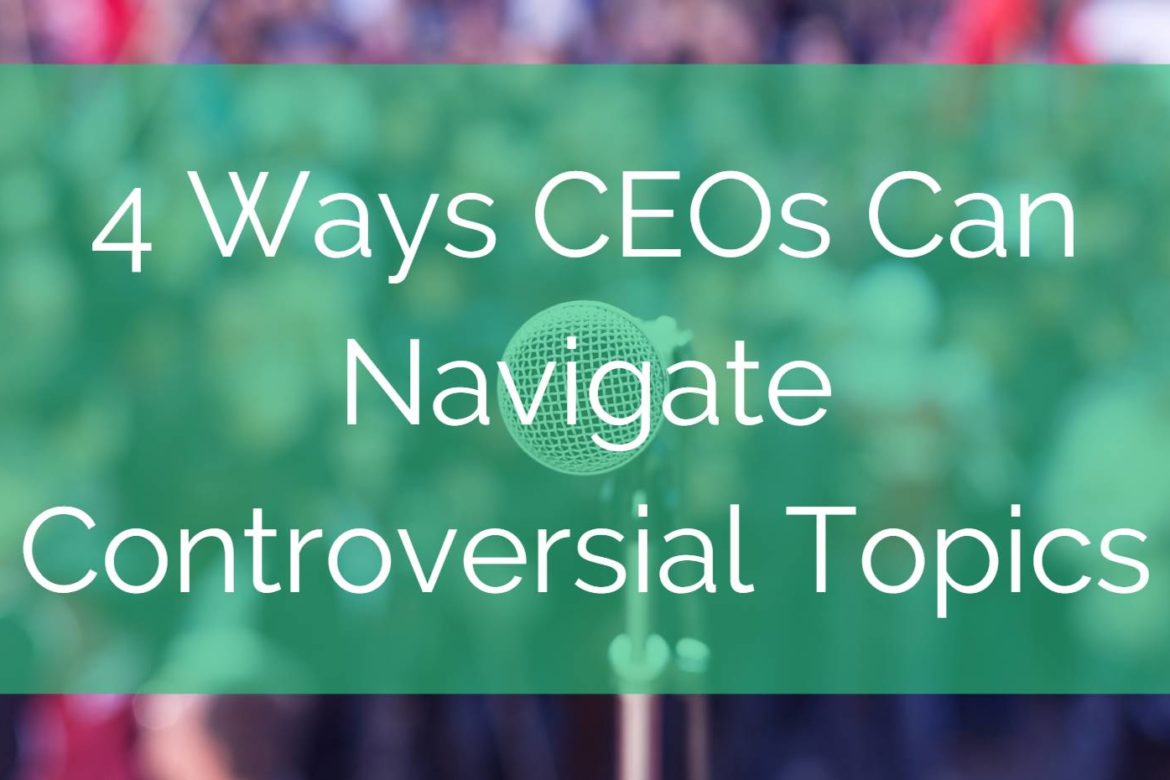In an article in the Washington Post last year, Morning Consult cautioned companies and CEOs about taking a public stance on issues of the day because this could lead the company to be perceived as picking a political party – i.e. “Red” or “Blue”. This article highlighted the crucial fact that the stakeholders of a company – its shareholders, partners, employees, customers, and the community – look to the CEO as an extension of the company brand, and CEO’s do not have the luxury of staying out of the limelight. A CEO’s public stance on an issue is an extension of the company image. Sometimes this means taking a potentially controversial stance to reflect the company’s values. What the survey results also showed was that different groups wanted companies to stand up for their values – however not get political. Here are a few key results from the Morning Consult survey:
- Sixty percent of the national sample of 2,200 adults said corporations generally should not get involved in political or cultural matters, compared with just 22 percent who said they should use their influence.
- Younger consumers and liberal voters were somewhat more likely to want companies to get involved — 36 percent of Gen Z respondents (ages 18 to 21), for example, said they wanted to hear from companies, while just 19 percent of Baby Boomers said the same.
“A recent report by the public relations firm Weber Shandwick, meanwhile, found that — when asked a different way — consumers did want to see a CEO “speak out when their company’s values are violated or threatened,” with 81 percent of women and 74 percent of men agreeing with that statement. “ – Jena McGregor, Survey: There is generally no upside for companies to talk about Trump, Washington Post.
The question then remains: how can a CEO be a visible thought leader without pushing her/his brand into a political fight that may alienate stakeholders? In other words, how can a CEO be visible in a way that minimizes risk and protects reputation as much as possible, but still engages with the community in a thoughtful, intentional way? At Brand Mirror we provide CEO brand reputation management in Washington D.C. our services include building presence on LinkedIn and other social media, as well as working on personal branding. We are dedicated to helping you build your brand while empowering your employees to be more successful with our team development workshops. Below we provided some recommendations to help CEOs navigate these challenging times.
1. Know Your Stakeholders
A CEO needs to be careful and take a position that aligns with company values. To do this, the CEO must intimately understand these values and know which of the stakeholders share them. Doing the research to get to know the constituents will help a CEO to frame a position that aligns with the company brand. The closer a topic or position aligns with the company brand – the more logical it is to your audience that the company and its leadership are taking a stand.
Nike is a great example of a controversial stance. The “Just Do It” promotion featuring Colin Kaepernick aligned with Nike’s edgy brand as well as its history of taking a stance on controversial topics. Nike willingly engaged with a risky topic to enhance its brand. And it worked as evidenced by the sales increased by over 30% as a result of the campaign. Just like Nike understood that its target audience would embrace a rebel athlete, CEO’s should consider what will be embraced by their stakeholders. For all of the customers who did not appreciate the ad, it seemed as though Nike was okay not having them as future customers. Even with the latest Betsy Ross sneaker, it is unclear what the impact on Nike will be, although the short term is absolutely an increase in visibility. What is clear is that they should have done more vetting before launching these sneakers. Given this shoe was a repeat of a sneaker 15 years ago, Nike could have kept it simple and kept the flag, vs. being too clever in trying to celebrate historical women figures AND the flag.
2. Know Your Narrative
The blowback that might come after taking a potentially controversial stance can quickly spiral out of control without a firm grasp of the narrative. A marketing campaign by Levi’s is a great example. Levi’s wanted to take a stand on reducing gun violence – a relatively benign position in isolation. However, because the issue of guns is always deeply connected to the question of gun ownership and the Second Amendment, Levi’s became mired in a public relations crisis when its campaign created the perception that Levi’s was opposed to gun ownership. Since then Levi’s has worked hard to ensure the narrative reaffirms the safety aspect and that their stance is not about Second Amendment rights.
“I think it’s imperative that companies not be afraid to weigh in on the issues that are really impacting the world,” says CEO Chip Bergh – Fast Company article “Inside Levi’s Stand Against Gun Violence.” by Adele Peters.
If the position may be controversial, then an isolated stance is never going to stay isolated. Public perception, including that of the company stakeholders, will place the stance in a context, and that context is where problems can begin. Before taking a stance, be thoughtful about the narrative – the context in which a stance might be placed. If there is room for multiple interpretations, then cut those off with clarity in the message. Control the narrative.
3. Have an Intentional CSR (Corporate Social Responsibility) Strategy
When a company thinks about engaging in corporate social responsibility (CSR), the typical action is to “cut a check.” When a CEO thinks about taking a stance, it is a statement. These two approaches need to meet and align. More importantly, the CSR approach must engage the community in an authentic and credible way. Understand the context of your company’s position and conceive of a strategy that allows the stakeholders to connect with your position. A CSR strategy can be something that allows employees to volunteer time, impacts the community positively, or otherwise allow stakeholders to have an authentic, meaningful experience living the company’s values. A good CSR strategy intentionally utilizes the time, talent, and treasure of the company resources to put its thoughts into action.
“The public is impressed when a company proves by its actions — and its CEO’s actions — that it stands for important principles and is willing to make hard choices based on those principles. These messages come from the news media, not from paid advertising or sustainability reports. The company must take a bold and timely stand on one or a few important social issues.”
HBR: The Right Way for Companies to Publicize Their Social Responsibility Efforts, by Mark Kramer.
4. Listen Assess and Re-adjust As Needed
Taking a stance on an issue isn’t the same as choosing a hill to die on. A CEO can look to the reactions of stakeholders and reconsider the strategy to reclaim the intended narrative. It is important to monitor feedback and identify the interests and priorities of key stakeholders – like employees, partners, the Board of Directors, regulators, etc. Know what is important to them, and be certain that your position, and the narrative, align. Create opportunities for engagement and feedback through volunteering, town halls, focus groups, or other ways for the stakeholders to demonstrate agreement, dialog, and endorsement (or even disagreement) with a position. This can be a great talent retention technique and a critical way to provide visibility in order for employees to know, like, and trust the CEO.
In today’s world, staying out of politics is increasingly impossible for a CEO. So much has become politicized that making a statement, however benign, can thrust the CEO and company into controversy. But today’s CEO has to be the face of the company; a complementary personal brand is critical to the success of the overall company brand. A thoughtful, intentional engagement in public discourse can be done with planning and care. Consider a professional brand reputation management consultation with BrandMirror today!
BrandMirror: Professional Brand Reputation Management in Northern Virginia
Jen Dalton, CEO of BrandMirror, has over 15 years of experience in strategy, marketing, and coaching. In 2012, she made a gutsy move into the entrepreneurship space, launching her branding business and became a certified master personal branding strategist. She specializes in building your digital thought leadership on LinkedIn and other social media. You can find her bestselling book, The Intentional Entrepreneur, on Amazon, which highlights how business owners can leverage their personal brand to grow their business faster.
Are you a CEO interested in learning how to maintain your brand? Book your brand reputation management consultation today by Contacting us at (703) 898-8691!

